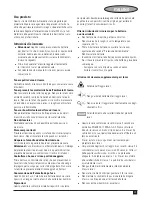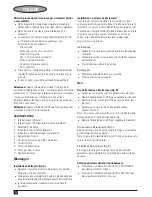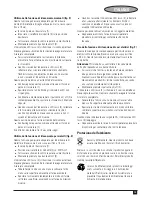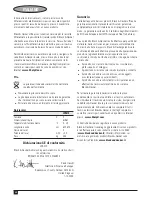
5
ENGLISH
- Very humid conditions
- Shielded cables
◆
Before use, always test the tool by detecting a known
pipe or wire.
◆
If in doubt contact a qualified contractor.
Warning!
This tool will not detect wires in circuits isolated
from the mains supply, cables operating at direct current (DC)
or wires used for telecommunication or computer systems.
Hidden wires (e.g. wall lights) may not be detected when
switches are in the off position.
Warning!
This tool will not detect pipes of any other material
than metal.
Features
1. On/off switch (laser)
2. On/off switch (stud/metal finder)
3. Mode selector switch
4. LED indicators (stud/metal finder)
5. LED indicator (wire detector)
6. Insert holder
7. Marking/hanging insert
8. Keyhole insert
9. Spacer insert
10. Drywall pin
11. Laser apertures
Assembly
Fitting the battery (fig. A)
◆
Depress the release button and remove the battery cover
(12) from the tool.
◆
Connect the battery to the connector. The larger battery
terminal connects to the smaller connector terminal.
◆
Refit the cover and let it click into place.
Fitting and removing inserts
The marking/hanging insert (7) is used to make a mark on the
level line or to hang the tool on a drywall board using the
drywall pin (10) supplied. The keyhole insert (8) is used to
hang the tool on other types of wall using a screw or nail.
The spacer insert (9) is used to extend the laser line.
Fitting
◆
Place the insert into the holder from the back of the tool.
◆
Align the notches on the insert with the recesses in the
insert holder (6).
◆
Let the insert click into place.
Removing
◆
Keep the notches on the insert depressed.
◆
Push the insert out of the holder.
Use
Using the laser level function (fig. B)
◆
Place the tool flat against the wall as shown.
◆
Push the on/off switch (1) up to switch the tool on.
◆
Move the tool as necessary to position the laser lines.
◆
If necessary, hang the unit on the wall using the
appropriate insert.
Note: the laser lines will only be level if the tool is kept within
5° from vertical.
◆
Push the on/off switch (1) down to switch the tool off.
Using the spacer insert (fig. C)
If you need to extend the laser line, use the spacer insert (9)
as shown.
Note: the stud sensor cannot be used with the spacer insert
fitted.
Enhancing the visibility of the beam (fig. D)
If because of the lighting conditions it is difficult to see the
laser line, you can use one of the inserts as shown to enhance
the line.
Selecting the operating mode
◆
Set the mode selector switch (3) to the ‘STUD’ position for
the detection of wooden studs.
◆
Set the mode selector switch (3) to the ‘METAL’ position
for the detection of metal studs, pipes, etc.
Using the stud finder function (fig. E)
You can use this function to find wooden and metal studs
through drywall boards up to 18 mm thick.
◆
Fit the marking insert (7).
◆
Set the mode selector switch (3) to the required position.
◆
Place the tool flat against the wall as shown.
◆
Keep the on/off switch (2) depressed.
The red LED indicator (4) will light up and the buzzer will
sound once while the tool is calibrating. After calibration is
completed:
◆
Slowly slide the tool in a horizontal direction. Make sure
not to tilt or lift the tool.
◆
When the red LED indicator (4) lights up, slow down and
slide the tool further until the buzzer sounds and the top
green LED indicator is on.
This position indicates the one edge of the stud.
◆
Mark this position through the hole in the marking insert
(7).
◆
Move the unit further until the LED indicators are off.
◆
While still keeping the on/off switch (2) depressed, move
the tool in the opposite direction.
Содержание LZR210
Страница 2: ...2 D B A 12 ...
Страница 3: ...3 DETECTION ZONE HERE EDGE LOCA TION F E ...




















